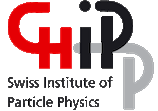Conveners
CHIPP/CHART: Poster session
- Lorenzo Giannessi (Universite de Geneve (CH))
The FCC-ee is a proposed future e$^+$e$^-$ collider capable of producing all SM particles in large quantities and clean experimental conditions. Up to four experiments can detect the collision products, with IDEA being one of the proposed detector concepts at FCC-ee. IDEA needs to fulfil requirements similar to experiments at other proposed lepton colliders such as reliable particle...
For the High-Luminosity phase of the LHC (HL-LHC) the ATLAS detector will undergo a series of upgrades to cope with the increased number of proton interactions and harsher radiation environment. One of the key projects in this suite of upgrades is the ATLAS Inner Tracker (ITk) and its pixel detector, which will have unprecedented granularity and number of channels, that require extreme...
The LEMING experiment at the Paul Scherrer institute aims to measure the free fall of muonium (M $= \mu^+ + e^-$), an exotic atom consisting purely of leptons. Measuring the free fall of M would be the first test of the weak equivalence principle using elementary antimatter of the second generation and using a system without large hadronic contributions to its mass.
Such a direct measurement...
The first search for the Z boson decay to $\tau\tau\mu\mu$ is presented. The data analyzed were collected by the CMS experiment at the CERN LHC in proton-proton collisions at a center-of-mass energy of 13 TeV and correspond to an integrated luminosity of 138 $\mathrm {fb^{−1}}$. Targeting tau lepton decays to muons and the corresponding
neutrinos, events with two pairs of oppositely charged...
Introduction to PIONEER, a next generation rare pion decay experiment located at PSI.
The LEMING (LEptons in Muonium INteracting with Gravity) experiment aims to measure the gravitational acceleration of Muonium (M = e$^−$ + $\mu^+$ ) in the gravitational field of the earth. An essential part of this experiment is the reliable detection of M’s decay products, i.e. e$^+$ and e$^−$, at temperatures below 1$\,$K. The electron, referred to as atomic electron, can be accelerated to...
Beyond the minimal kinetically-mixed dark photon scenarios predicting fully visible and fully invisible mediator decays, next-to-minimal theories have been considered as compelling frameworks for thermal dark matter and some low-energy anomalies, as the muon g-2.
This talk will showcase the potential of the NA64 experiment in the exploration of rich dark sectors in which the dark photon is...
NA64 is a fixed-target frontier experiment running at the CERN SPS. NA64 searches for possible candidates of mediators between the dark sector and the standard model by looking for missing energy events in an active beam dump. After resuming data taking in 2021, NA64 has tripled its statistics, allowing us to set leading constraints to dark sector mediators in the light dark matter parameter...

